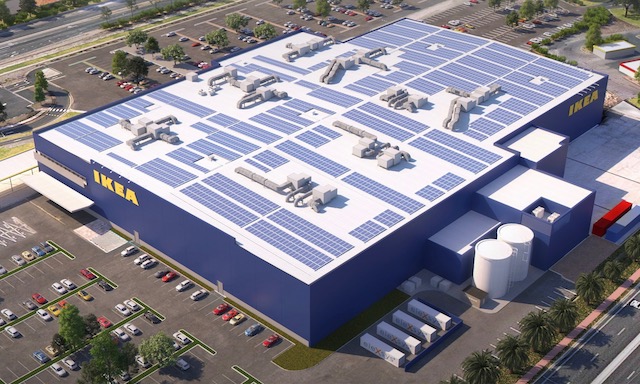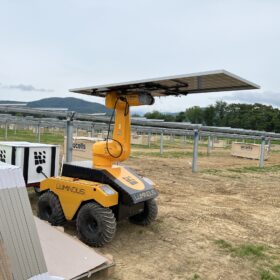In the context of COP26 achievement so far, a moonshot is called for, and one Australian company is calling it. Behind the scenes of the Glasgow Climate Change Conference, eleXsys Energy is agitating for businesses and municipalities to Just Look Up for a simple solution to the huge problem of global warming: it’s positing that if 50% of all global rooftops hosted solar, their combined output could provide 100% of the world’s current electricity needs.
What the world doesn’t yet fully understand, says Richard Romanowski, Executive Director and Co-founder of the global-award-winning eleXsys Energy combined hardware and software solution, is that the problems of connecting huge amounts of variable solar and wind generation to the grid can be solved by taking renewables-powered commercial enterprises, villages and regional towns off the grid and enabling them to sell services and energy back into the network, as required, via wholesale-energy-market and FCAS-market participation.
Licensed in its home country to Planet Ark Power, eleXsys Energy is in the process of installing 1.9 MW of solar generation on the rooftop and car park of the Adelaide Airport IKEA store in South Australia, alongside a 3.36 MW/3.45MWh lithium battery supplied by CATL and the unique eleXsys Energy management system.
The flagship for hundreds more such C&I installations, this IKEA microgrid will allow the homewares megastore to be 100% powered by onsite renewables by 2025, while reducing its energy costs by a forecast 25%.
In addition, the eleXsys control platform has allowed a system more than 10 times the accepted “safe” size for grid interaction to be connected in solar-rich South Australia, which leads the world in addressing the problems associated with renewable-energy exports.
For regional towns that link rooftop solar on businesses, community buildings and residences to grid-scale storage, an eleXsis-managed microgrid will supply cheap electricity that lowers the cost of doing business, provides a sustainable point of difference to the locality’s products and produce, and helps new enterprises thrive.
“When you take a village or a small city that is struggling and give it clean, cheap energy, it can start new businesses, integrate vertical farming, it sparks a whole range of different things that will grow a community rather than having it slowly diminish,” says Romanowski.
Forward in solving the backwards flow of energy
EleXsys, says Romanowski, solves problem of backward flow of energy from distributed generators — utility-scale and small-scale — destabilising electricity grid voltages.
The compact, scalable hardware device is controlled by AI-based software to deliver services previously provided by deploying multiple devices: it is a grid-forming inverter, a battery charger and speed controller with power-factor correction capabilities — call it a dSTATCOM, aka a distribution static synchronous compensator.
Developed over several years by former energy utility engineer, Bevan Holcombe, and brought to market by clean-energy entrepreneur and co-founder of renewable-energy solutions provider Planet Ark Power, Romanowski, eleXsys Energy has solved the problem of solar curtailment, but another crucial part of its appeal is that it enables an investable solar-poweredbusiness model.
In the context of commercial and industrial transition to solar in particular, it allows the the entire solar-generation, storage and market-participation ecosystem to be independently owned by an entity paying rent to the property/building owner, then selling the world’s cheapest electricity (without added network costs) to the building tenant(s) or owner, and making money by providing services to the grid.
The IKEA project, for example, is owned by a superannuation fund, “and the reason they’ve invested is because with eleXsys they get a 20-year secure income stream”, Romanowski tells pv magazine Australia.
A bankable avenue for green investors
In 2019, when Planet Ark Power won the World Energy Council (WEC)/German energy agency (dena) Start Up Energy Transition Award for the eleXsys Energy technology, Sandrine Dixson-Declève a global expert in the socio-political challenges of energy transition in response to climate change, said to Romanovski, “Wow, this releases trillions of dollars that want to invest into decarbonisation, because you make it bankable. But how do you explain that in 10 seconds?” or words to that effect.
Also at the time of the company’s WEC/dena win, Romanowski says, the Secretary General of the World Energy Council, Christof Frei, told him, “This technology is game changing. We need you to think 100 times bigger, to help us decarbonise the world.”
That’s one factor behind eleXsys Energy taking its “Just Look Up” challenge to COP26. The other is a growing body of research from experts at institutions such as University College Cork in Ireland, working with Columbia University in the US and Imperial College London, as well as the 2019 Australian PV Institute report on the potential for rooftop solar generation in Australia, which indicate that rooftops, commercial and residential, have the latent, sun-soaked space to change the emissions-climate equation.
Technologies like eleXsys can realise that rooftop potential, and deliver energy to customers that is already as cheap as Angus Taylor’s shot at the moon, says Romanowski.
That is, if you take out the network and transmission components of your energy bill (as IKEA will be able to with its onsite generation and storage), solar energy is already at 10 cents per kilowatt; where Taylor’s challenge for solar farms to achieve costs of 1.5 cents/kW does not calculate the addition of likely 10 cents/kW in the cost of upgrades to transmission and distribution infrastructure, and even a little more besides for the cost of curtailment…
Set to Just Look Up in the UK and US
EleXsys is focused on scaling up recognition and delivery of its technology, and is not relying on the success of its COP26 lobbying; the company will go global by mass licensing its software and hardware as a service into countries where electricity markets enable strong investor returns.
“We’re working first on a market-entry business strategy to the UK, and our second market entry is into Pennsylvania in the US,” says Romanowski.
The UK, he says, already has in place similar FCAS and wholesale-market mechanisms to Australia.
In the US, the Federal Energy Regulatory Commission Order No. 2222, “which is proposing that you can participate in the auxiliary services and in the wholesale market from behind the meter, is just a couple of months off”, says Romanowski.
Therefore, he says, in three markets — Australia, the UK and the US — which have those market mechanisms, the much-referred-to expense of battery technology today is no barrier to the immediate viability and saleability of the eleXsis proposition. “Battery prices already are cheap enough to make it work,” says Romanowski.
In Australia, he points out, we can do 750 IKEA-equivalent projects today and replace a coal power station, without any permission or subsidy — we don’t need government grants or any change in government policy.”
Businesses staring down the commitment to net-zero carbon emissions can Just Look Up.
This content is protected by copyright and may not be reused. If you want to cooperate with us and would like to reuse some of our content, please contact: editors@pv-magazine.com.









By submitting this form you agree to pv magazine using your data for the purposes of publishing your comment.
Your personal data will only be disclosed or otherwise transmitted to third parties for the purposes of spam filtering or if this is necessary for technical maintenance of the website. Any other transfer to third parties will not take place unless this is justified on the basis of applicable data protection regulations or if pv magazine is legally obliged to do so.
You may revoke this consent at any time with effect for the future, in which case your personal data will be deleted immediately. Otherwise, your data will be deleted if pv magazine has processed your request or the purpose of data storage is fulfilled.
Further information on data privacy can be found in our Data Protection Policy.